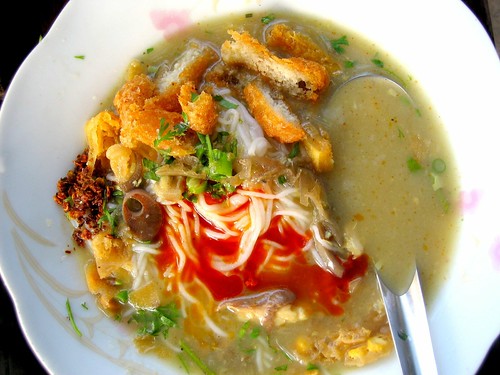 |
| Mohinga, Burma's Breakfast of Choice |
Bursting with contrasting textures, fragrances, and flavours, mohinga is a Burmese catfish chowder served over rice vermicelli. It's the breakfast of choice wherever you go in Burma, and considered our national dish.
As soon as we're back in Yangon, my family and I will devour bowl after bowl of mohinga, brought home in huge metal tiffin carriers from the nearest street vendor, or eaten in situ at our favourite stall.
Heaped with crispy split-peas, slices of soft duck egg, bouncy fishcake, and fresh feathery coriander leaves, with extra fish sauce and lime to squeeze on the side, it's hard to know when to stop, and for many, their love for mohinga borders on obsession.
Mohinga is usually made with small river catfish known in Burmese as nga gyi, nga ku or nga yunt which I believe are related to the Pangas catfish.
While you can't get the same fish in the West, I've found that a combination of tinned mackerel and sardines can successfully replicate the flavour of authentic mohinga. My father said, in slightly offensive astonishment, that this tastes "just like the real deal".
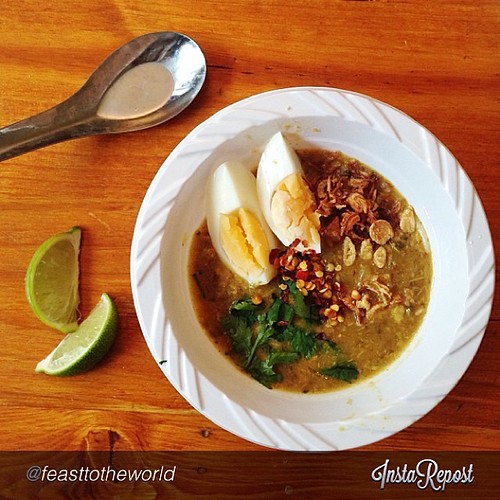 |
| Photo by Feast To The World |
Burmese Catfish Chowder - Mohinga Recipe
Serves 6-8
For the broth:
- 5 tbsp gram flour
- 2 tbsp rice flour
- 2 tins of mackerel in brine (~200g)
- 1 tin of sardines in oil (~100g)
- 500ml vegetable or fish stock
- 2 large onions, quartered
- Handful of shredded banana blossom (see NOTE below)
- 1 tbsp fish sauce (known in Burmese as ngan-bya-yay)
For the spice paste:
- 4 cloves garlic, peeled
- 3cm knob of fresh root ginger, peeled
- 2 lemongrass stalks, trimmed of woody bits
- 1 small bunch of fresh coriander, stems only
- 6 tbsp groundnut or other neutral oil
- 1 tbsp mild chilli powder
- 1 tbsp ground turmeric
- 1 tsp hot paprika
- 1 tsp freshly ground black pepper
To serve:
- 600g dried rice vermicelli noodles
- 200g ready-made fishcake, sliced (available from Oriental/Asian supermarkets)
- Wedges of hard-boiled eggs
- 1 small bunch of fresh coriander leaves, chopped
- Fried shallots
- Lime wedges
- Fish sauce
- Chilli oil
- Yellow split pea crackers (be-gyun kyaw) (recipe to follow)
- Crispy garlic oil (recipe to follow)
Toast the gram flour and rice flour by tossing in a dry frying-pan on a medium-high heat for 5-6 minutes till fragrant. Watch like a hawk and keep moving the pan, since it can catch and turn black in seconds. Leave to cool and then sieve the toasted flours.
Whisk the sieved flours with 500ml water in a bowl or jug till smooth. Set this flour solution to one side.
 |
| Toast the flours |
Now make the spice paste - blitz the garlic, ginger, lemongrass and coriander stems in a blender or food processor until it forms a purée.
Heat the oil in a stockpot on medium-high and add the purée and the rest of the spices. Fry for 3-4 minutes till fragrant.
 |
| Fry the spice paste |
Now add the fish as well as the oil and brine from the tins to the stockpot and mash them with a masher or a fork till smooth.
Stir to combine with the spice paste and then add the flour solution you made earlier as well as the stock.
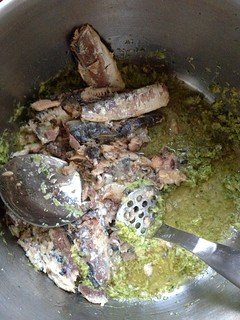 |
| Mash the tinned fish |
Bring to the boil, turn the heat down to medium and simmer vigorously for 30 minutes.
Now add the quartered onions, the banana blossom if using and 2 litres of water, turn the heat down to medium-low and simmer for 2 more hours, stirring from time to time.
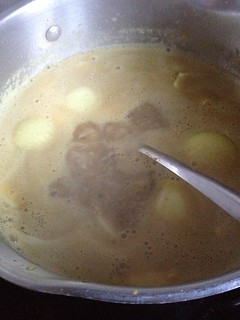 |
| Simmering onions |
Meanwhile, put the noodles into a heatproof bowl, generously cover with just-boiled water, untangle with a fork and then leave to soak for 15 minutes. Drain the noodles into a colander and rinse them thoroughly with cold running water.
Leave the colander in the sink to allow any residual water to keep draining. The Burmese don't like mushy or starchy noodles and this process gives the best result.
 |
| Rice vermicelli draining on the top left |
Just before you're ready to serve, heat 2 tablespoons oil in a frying-pan on medium, add the fishcake and fry for 5 minutes till golden. Set to one side.
When you're ready to serve, stir the fish sauce into the stockpot of broth.
Now divide the noodles amongst pasta plates (should be about a handful in each), and ladle the hot soup on top (which will reheat the noodles).
Garnish each dish with fishcake, chunks of split pea cracker, egg and coriander leaves and serve with lime wedges, fish sauce and chilli and garlic oil on the side.
As for utensils, ideally you should use metal Chinese spoons as you can see in all the photos and the video. We actually call them mohinga zun which means "mohinga spoons" in Burmese.
Failing that, use tablespoons, but never ever ever eat mohinga with chopsticks - it's the heinous equivalent of heating gazpacho ...
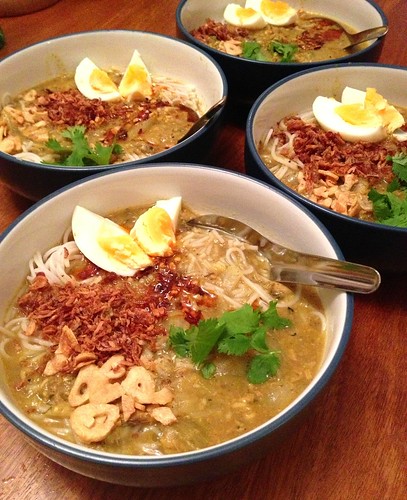 |
| All for me ... |
NOTE: Mohinga should be made with the stem of the banana plant, but this isn't available in the West as far as I know. A good substitute is fresh shredded banana blossom - you can buy whole flowers/buds and prepare it yourself (just the white part) or buy ready-sliced in packets in Vietnamese supermarkets where it's known as Bắp Chuối.
Here's a good review of where to eat mohinga in Yangon, by the London Review of Breakfasts.
Comments
Thanks for sharing.
"Chowder" is a term which implies a thickened fish or seafood stew eaten with crackers. It's a perfectly adequate way of explaining mohinga to people who aren't familiar with it. And if I used the word "casserole", I suppose you'd accuse me of wanting to be French.
Why on earth are you so rude? And I'm very proud of being a ngapi girl - I'm Burmese so ngapi runs through my veins.
(incidentally, to the rest of my readers, "Anonymous" went to the trouble of emailing me a MUCH more abusive version of this comment using a programme that hides the identity of the sender. Nice person.).
One question - any chance you would publish the recipe for the be-gyun kyaw? The recipe says 'coming soon' but couldn't find it in your index of recipes.
Thanks again :)